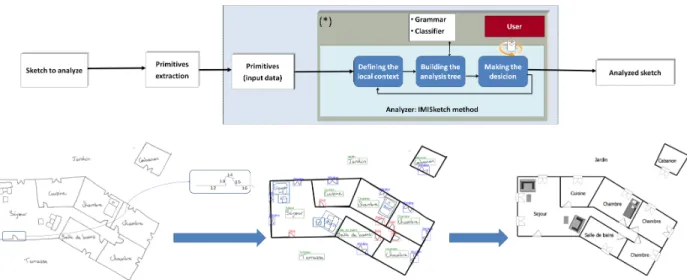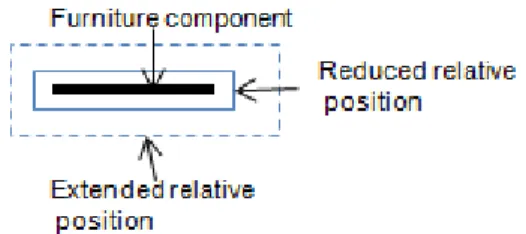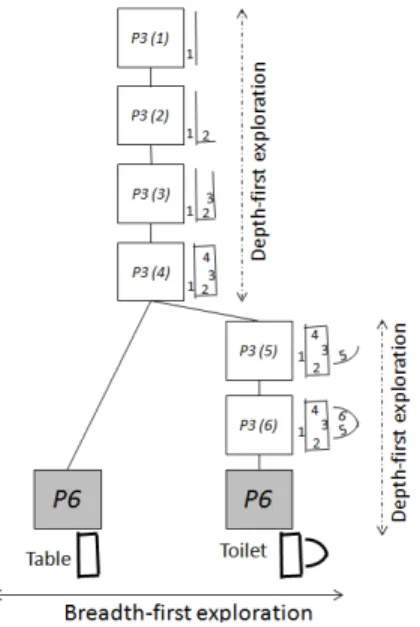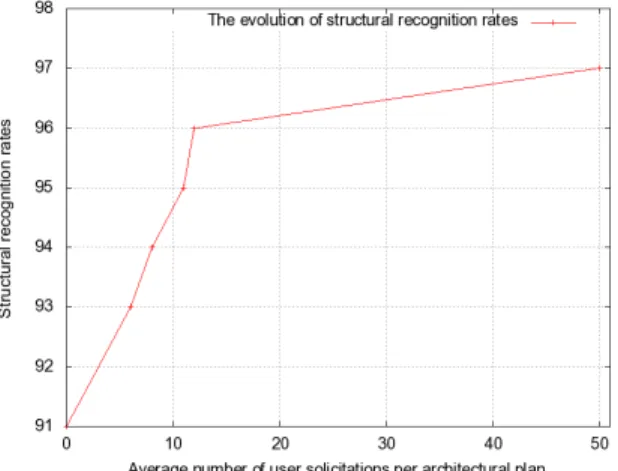HAL Id: hal-00738470
https://hal.archives-ouvertes.fr/hal-00738470
Submitted on 4 Oct 2012
HAL is a multi-disciplinary open access
archive for the deposit and dissemination of
sci-entific research documents, whether they are
pub-lished or not. The documents may come from
teaching and research institutions in France or
abroad, or from public or private research centers.
L’archive ouverte pluridisciplinaire HAL, est
destinée au dépôt et à la diffusion de documents
scientifiques de niveau recherche, publiés ou non,
émanant des établissements d’enseignement et de
recherche français ou étrangers, des laboratoires
publics ou privés.
Competitive hybrid exploration for off-line sketches
structure recognition
Achraf Ghorbel, Aurélie Lemaitre, Eric Anquetil
To cite this version:
Achraf Ghorbel, Aurélie Lemaitre, Eric Anquetil. Competitive hybrid exploration for off-line sketches
structure recognition. International Conference on Frontiers in Handwriting Recognition
(ICFHR-2012), Sep 2012, Bari, Italy. pp.569-574. �hal-00738470�
Competitive hybrid exploration for off-line sketches structure recognition
Achraf Ghorbel
Irisa - INSA Rennes
Campus de Beaulieu
35042 Rennes Cedex
achraf.ghorbel@irisa.fr
Aur´elie Lemaitre
Irisa - Universit´e de Rennes 2
Campus de Beaulieu
35042 Rennes Cedex
aurelie.lemaitre@irisa.fr
Eric Anquetil
Irisa - INSA Rennes
Campus de Beaulieu
35042 Rennes Cedex
eric.anquetil@irisa.fr
Abstract
We work on new strategies of exploration for inter-pretation of off-line sketches. A first approach (call IMISketch) was based on a competitive breadth-first ex-ploration of the analysis tree allowing to evaluate si-multaneously several possible hypotheses of recogni-tion in a dynamic local context of document. A great advantage of this strategy is to be able to solicit the user during the decision process to avoid error accumulation in the analysis step. IMISketch strategy is very interest-ing but it can lead combinatory problems when address-ing complex sketches. In this paper, we propose a new hybrid strategy for exploration. The recognition pro-cess alternates between a breadth-first and depth-first exploration. The strategy is totally driven by the gram-matical description of the document. The paper demon-strates the interest of this new hybrid strategy method on handwritten 2D architectural floor plans containing walls, opening and furnitures.
1. Introduction
IMISketch [5] is an interactive syntactic method for interpretation of structured documents. A priori structural knowledge of the document in IMISketch is expressed through a two-dimensional visual lan-guage based on production rules. This analyzer aims to interpret the image primitives. These primitives are line-segments and polygons. IMISketch adopts a breadth-first exploration unlike classical syntactic anal-ysis methods [1] [2] [3] [8] based on depth-first explo-ration. Each branch of the tree is a possible hypothe-sis. The uncertainty is formalized by the attribution of scores to each hypothesis. If the ambiguities can not be resolved in an automatic manner, the user will be so-licited by the analyzer to resolve the ambiguity. The user integration in the recognition loop avoids error
ac-cumulation and thus a fastidious a posteriori correction. The first results of this method performed on the archi-tectural plans containing walls and opening are promis-ing [5]. The presence of the user in the loop analysis requires a reasonable analysis time. For this, we pro-posed in [4] some optimizations to accelerate the inter-pretation.
When we analyze some architectural plans contain-ing more complex furnitures, we note that the current IMISketch generates a lot of combinatory due to the presence of many basic primitives in a small zone.
In this paper, we focus on a new strategy of ex-ploration to reduce the combinatory to obtain an an-alyzer that is really exploitable in the context of an interactive analysis. This strategy consists in passing from a method based only on breadth-first exploration to a hybrid method that alternates between breadth-first and depth-first exploration. At each step of analysis, the type of exploration will be induced by production rules of the two-dimensional grammar that will drive the analysis. The choice of exploration type is induced by the risk of the current interpretation relatively to its neighbours. An interpretation is called low-risk when the analyzer is sure to combine the right primitives that form an entity. Depth-first exploration is adopted in the low-risk interpretation cases. In other cases, the analyzer adopts a breadth-first exploration allowing to evaluate simultaneously several possible hypotheses of recognition in the current local context of the document. The complete system can be applied to off-line docu-ments (images). We validate this new hybrid strategy on handwritten architectural plans. Some examples are illustrated in Figure 9.
The remaining of the paper is organized as fol-lows. In the section 2, we introduce the principles of our existing interactive analysis method for interpreting sketches, IMISketch. The new hybrid strategy is de-scribed in section 3. Experimental results are reported in section 4 and finally, section 5 concludes the paper.
Figure 1. Synthetic scheme of IMISketch method for structured documents interpretation
2. Overview of IMISketch
In this section, we present the different steps of the existing method IMISketch (cf. Figure 1). The first step is the extraction of basic primitives required for analy-sis. The second main step is to analyze these primitives and to use their structural arrangement in the document to identify the symbols. This phase is interactive: the analyzer can solicit the user to resolve ambiguity cases. The recognition of the document structure is managed by a grammatical analyzer that drives the calls of sym-bol classifiers to evaluate a scoring for each hypotheses. We now detail each step of analysis.
2.1
Preprocessing phase: Primitive extraction
The first step consists of extracting the necessary in-formation from the structured document. This phase is generic and off-line and does not depend on the type of document to interpret. We have chosen to work only with line-segments, which represents the primitives of our analysis. We adopt the Kalman filter to extract these primitives [6] presented in figure 2.2.2
Interactive
breadth-first
exploration:
IMISketch
IMISketch analyzer explores the matching between the document structure defined by grammatical rules and the set of primitives contained in the document. The grammatical rules are expressed using the context-driven constraint multiset grammars (CD-CMG) [7]. In CD-CMG, when a production reduction occurs, it
Figure 2. Extraction of primitives. The
original drawing is in light gray, and the extracted primitives are in black.
means that a multiset of elements is replaced by another one α. This reduction has impacts on the analysis of the document: now that new α elements exists in the docu-ment, it may be possible to add new others, positioned relatively to these α elements. The interpretation of α creates a new zone, called relative position to search the next elements to analyse in the document.
The primitive interpretation depends on its neigh-bourhood in structured documents: the structured docu-ment analysis requires a two-dimensional context. The analyzer begins by defining a spatial contextual focus that aims to limit the combinatory exploration due to the breadth-first exploration of the analysis tree.
Each primitive can be interpreted in several ways which led to a construction of an analysis tree. In the building of the analysis tree, the analyzer explores all the possible hypotheses of interpretation using breadth-first exploration in the spatial context with the algorithm described in [4]. Each root is the production rule that would consume this primitive. Each node or leaf is the
application of a production rule deduced from the pre-vious node. The number of analysis trees corresponds to the number of possible interpretations for the current primitive.
Once the tree is constructed, we start the decision phase. The role of the decision process is to validate the right hypothesis among a set of competing hypothe-ses generated with a breadth first analysis. The ana-lyzer solicits the user in case of ambiguity, i.e. when more than one hypothesis can be validate with almost the same score. Otherwise, the analyzer validates the best hypothesis.
When the correct root is validated, other roots are put on hold and the new roots are either the sons of this root if exists, or the waiting roots otherwise. The analyzer goes back to the first step (defining the local context). The analysis is complete when no more production rule is applicable.
2.3
IMISketch application on furniture
In this section, we present an example of interpre-tation produced by IMISketch. We want to analyze the primitives {1,...,6} illustrated in Figure 3 with the gram-mar described in Figure 4. In the gramgram-mar, each new interpreted element induces the creation of a new rela-tive positionfor the search of the following elements to recognize. We are mainly interested in the combinatory at the analysis tree level. According to Figure 4, there are two ways to interpret the primitive ’1’:• As wall: the Figure 5 shows the analysis tree cor-responding to all the hypotheses generated by this interpretation.
• As a part of furniture: the Figure 6 shows the part of analysis tree corresponding to some hypotheses generated by this interpretation. We present just a part of the tree analysis for more clarity. This analysis tree generates a lot of combinatory, and we obtain several equivalent hypotheses.
Ps (1) ( ) ( ) ( ) ( ) P1 (2) P2 (2) P1 (4) P2 (4) P1 (3) P2 (3) P2 (3) P1 (3) P2 (3) P2 (3) P2 (2) P2 (5) P2 (6) P2 (6) P2 (5) P2 (4) P2 (5) P2 (6) P2 (6) P2 (5) P2 (4) P2 (5) P2 (6) P2 (6) P2 (5) P2 (2) P2 (5) P2 (6) P2 (6) P2 (5) P2 (6) P2 (5) P2 (6) P2 (5) P2 (6) P2 (5) P2 (6) P2 (5) Breadth‐first exploration P3 (1) P3 (2) P3 (3) st expl orati o n Local context
1
2
4
P3 (3) P3 (4) P6 P3 (5) Depth ‐fir s p loration Breadth‐first exploration P3 (6) P6Toilet
Table
Depth ‐first ex p : Depth‐first exploration : Breadth‐first exploration Figure 3. Primitives to interpretName Created
l Consumed elements
Name
elements Consumed elements
Ps Starting wall Longest line in the document
P1 Wall Line at the end of an other wall
Line at the end of an interpreted wall or
P2 Sequence_Opening Line at the end of an interpreted wall or
sequence_Opening
P3 Sequence_Furniture A sequence and two colinear walls or a
sequence and wall and a line wich are colinear A sequence and two colinear walls or a
P4 Door A sequence and two colinear walls or a
sequence and wall and a line wich are colinear
P5 Window A sequence and two colinear walls or a
sequence and wall and a line wich are colinear
P6 Furniture A Sequence Furniture
P6 Furniture A Sequence_Furniture
Figure 4. Example of production rules used for the architectural plans
5 6 Ps (1) ( ) ( ) ( ) ( ) 1 2 3 4 P1 (2) P2 (2) P1 (4) P2 (4) P1 (3) P2 (3) P2 (3) P1 (3) P2 (3) P2 (3) P2 (2) P2 (5) P2 (6) P2 (6) P2 (5) P2 (4) P2 (5) P2 (6) P2 (6) P2 (5) P2 (4) P2 (5) P2 (6) P2 (6) P2 (5) P2 (2) P2 (5) P2 (6) P2 (6) P2 (5) P2 (6) P2 (5) P2 (6) P2 (5) P2 (6) P2 (5) P2 (6) P2 (5) Breadth‐first exploration P3 (1) P3 (2) P3 (3) st expl orati o n P3 (3) P3 (4) P6 P3 (5) Depth ‐fir s p loration Breadth‐first exploration P3 (6) P6 Toilet Table Depth ‐first ex p : Depth‐first exploration : Breadth‐first exploration
Figure 5. Analysis tree resulting from the interpretation of the primitive ’1’ as wall
Despite our previous optimizations on IMISKetch [4], the combinatorial problem remains a major problem especially when the documents are more complex than walls and openings. For example, the analysis tree for interpreting the primitive ’1’ in a component of furniture requires more than 50 nodes (Figure 6). We present in the next section, a new hybrid strategy to improve the exploration of the analysis tree.
Figure 6. Part of the analysis tree result-ing from the interpretation of the primitive ’1’ as furniture (should contain about 50 nodes)
3. Hybrid exploration
Symbols with a complex structure, such as furniture in the case of architectural floor plan, generates a lot of combinatory because they are composed of a big num-ber of primitives interconnected in a reduced zone. De-spite breadth-first exploration offers the possibility to choose between several possible hypotheses for inter-preting primitives, this exploration generates a lot of combinatory. In opposite, the depth-first exploration avoids combinatorial problems but does not generate all hypotheses. This exploration may suggest a wrong in-terpretation of primitives.
In this section, we propose a dynamic strategy to switch between a breadth-first exploration and a depth-first exploration to reduce the combinatory. We improve the use of the existing CD-CMG grammar to drive this new strategy analysis. In our hybrid strategy, CD-CMG is not restricted to the modeling of the document but also used for the choice of the exploration strategy: ei-ther breadth-first exploration or depth-first exploration.
3.1
Breadth-first / Depth-first exploration
The CD-CMG grammar drives the exploration of the analysis tree. It enables to choose between breadth-first and depth-first exploration at each step of analysis.
• depth-first exploration: this exploration strategy is chosen if the production rule applied at the root of the analysis tree generates only one way to inter-pret the other primitives of the same group (inter-connected primitives).
• breath-first exploration: if the interpretation of the root of the analysis tree generates several ways to interpret the primitives of the same group. As we have said previously the depth-first explo-ration may not generate all the hypotheses. Conse-quently, we propose to reduce the risks by limiting the possible zone of application of the depth-first analysis. We implement this idea using the concept of relative position.
3.2
Reduced relative position Vs extended
rel-ative position
We recall that the relative position is the search zone that is created after the interpretation of each element in order to continue the analysis. In this analyzer, we combine two kinds of relative positions (Figure 7):
• Extended relative position: this position is the same to that used in previously IMISKetch. When
this position is activated, the analyzer adopts the classical breadth-first exploration.
• Reduced relative position: this zone search is smaller and enables to adopt the depth-first explo-ration. This position is intended to collect inter-connected primitives that are very close.
In the grammatical description, each interpreted ele-ments can create the both kinds of relative positions. Thanks to these positions, the hybrid exploration is to-tally led by the grammatical description and can be adapted for the description of each element present in the document. If a created element is associated to two positions, the reduced position is used in priority. The transition from reduced position to extended position is established only after no rules of productions is appli-cable.
Figure 7. Example of two relative position for a furniture component
3.3
Example of hybrid exploration
In this section we return to the same example of sec-tion 2.3. Figure 3 illustrates the primitives to interpret and Figure 4 describes the production rules.
In the case of architectural floor plans, we consider that the close interconnected set of basic primitives be-long either to the same furniture(toilet, table, bed) or to one or more walls and openings (doors, windows); the not interconnected primitives elements belong to the same or different elements. For this, we have described in the grammar that the walls create only extended tive positions. The furniture rule now creates two rela-tive positions: reduced and extended.
Primitives {1, 2, 3, 4} are interconnected and form the group G1. Primitives {5, 6} are interconnected and form the group G2. By applying the production rules described in Figure 4, there are two ways to interpret the primitive ’1’: a wall or a component of furniture. Since the wall creates only an extended relative position, the analysis tree thus constructed is similar to IMISketch
(Figure 5). Figure 8 shows the analysis tree obtained with the new exploration strategy about how to obtain furniture. The analyzer uses the reduced relative po-sition to group primitives that can form a furniture by adopting an depth-first exploration. The group {1, 2, 3, 4} forms a table. The extended position is used to find another hypothesis of furniture. {1, 2, 3, 4, 5, 6} may form another furniture: toilet.
Figure 8. Analysis tree with Hybrid
explo-ration: transformation of primitive ’1’ to ta-ble or toilet.
With this new strategy, to interpret the primitive ’1’ as a component of a furniture, we pass from around 50 nodes with IMISketch to 7 nodes with the hybrid explo-ration. We have shown in this simple example, by ap-plying our new strategy on six basic primitives, we won 86% of exploration of nodes. This new hybrid strategy also lets alleviate the competitive hypotheses. In our example, this new strategy allows to pass from 6 com-peting hypotheses (Figure 6) to 2 hypotheses (Figure 8).
4
Experimental results
In this section we report results obtained from the hy-brid exploration strategy described in section 3 on the interactive method of document analysis. The aim of this strategy is to reduce the analysis time of the docu-ment to meet the criteria of acceptability and usability of the system.
The experiments were carried on 24 architectural plans of different complexity drawn by six different people. Each architectural plan is composed of a set of walls, opening (doors, windows and sliding windows) and furniture (single sink, double sinks, toilet, bathtub,
square table, table with chairs, single bed, double bed, shower, couch). Figure 9 shows some examples of ana-lyzed architectural plans and Figure 10 reports the total number of symbols of the database.
To evaluate our new exploration strategy, we adopt two experiments. The first one consists of comparing our new hybrid approach to IMISketch method (based on breadth-first exploration). In this experiment, we an-alyzed 7 architectural plans using IMISketch. This in-terpretation requires more than 5300 nodes per image and therefore a large computation time. The interpreta-tion of the same plans with our new explorainterpreta-tion strategy requires an average of 1713 nodes and thus acceptable computation time for an interactive method. This repre-sents a gain of 70% (Figure 11).
Today, the average computation time is 4 min per image. In future work, we will try to reduce the compu-tation time to attain around 1 min 30: experimentally, it seems the ideal timing that allows the user to follow in real time the recognition process.
The second experiment evaluate the rate of structural recognition, i.e. the interpretation of primitives into walls, openings and furnitures, using our hybrid strat-egy and the presence of the user in the loop of analysis. Figure 13 reports recognition rates based on 24 ar-chitectural handwritten plans with varying threshold of user solicitations. This figure shows the evolution of recognition rates related to the number of user solicita-tions. We can notice that the best compromise (recog-nition rates / user solicitations) is obtained with 12 user solicitations per image: it means that 4% of primitive interpretations require the user solicitation. 49% of user solicitations are useful to take the right decision which is not the best hypothesis proposed by the analyser. The structural recognition rates increase from 91% without user solicitations to 96% with user solicitations. The remaining errors (about 4%) are mostly due to badly drawn symbols.
With this strategy, we can deal with complex prob-lems where the furniture is attached to wall. Fig-ure 12(a) and FigFig-ure 12(b) present examples of furni-ture that share a component with a wall. Figure 12(c) illustrates an example of furniture that has a component attached to wall. Figure 12(d) and Figure 12(e) show examples of furniture that has a component attached to an opening. The interpretation of these cases is very difficult with IMISketch because large combinatory is generated ; but in these complex cases, the furniture are localized with the hybrid strategy.
(a) (b)
Figure 9. Examples of architectural floor plans
Number of architectural plans 24 Number of walls 961 Number of opening 414 Number of furniture 523
Figure 10. Database properties
IMISketch > 5300 Our new hybrid strategies 1713
Figure 11. Average of explored nodes number
Figure 12. Example of complex interpreta-tions
Figure 13. The evaluation of structural recognition rate
5
Conculsion
In this paper, we have presented a hybrid strategy for solving combinatory generated by an interactive analysis for the sketch recognition. This strategy al-ternates between a breadth-first and depth-first explo-ration. Note that this hybrid exploration is driven by the grammar. This strategy has been validated and tested on an interactive analyzer for interpreting handwritten architectural floor plans.
Future work will focus on extending the experimen-tal results on large image databases containing printed and vectored document architectural plans... We will also validate the criteria of acceptability and usability of the system by doing usage tests that will be conducted in collaboration with experts from the laboratory uses ”Loustic” (http ://www.loustic.net/rennes).
Acknowledgment
The authors would like to thank all the people who took part in the experiments. This work partially bene-fits from the financial support of the ANR Project Mo-bisketch.
References
[1] K. Chan and D. Yeung. An efficient syntactic approach to structural analysis of on-line handwritten mathematical expressions. Pattern Recognition, 33(3):375–384, 2000. [2] B. Co¨uasnon. Dmos, a generic document recognition
method: Application to table structure analysis in a gen-eral and in a specific way. IJDAR 2006, 8(2):111–122, 2006.
[3] J. Fitzgerald, F. Geiselbrechtinger, and T. Kechadi. Math-pad: A fuzzy logic-based recognition system for hand-written mathematics. In ICDAR 2007, volume 2, pages 694 –698, 2007.
[4] A. Ghorbel, E. Anquetil, and A. Lemaitre. Optimization analysis based on a breadth-first exploration for a struc-tural approach of sketches interpretation. In 10th IAPR International Workshop on Document Analysis Systems (DAS’12), 2012.
[5] A. Ghorbel, S. Mac´e, A. Lemaitre, and E. Anquetil. In-teractive competitive breadth-first exploration for sketch interpretation. ICDAR 2011, pages 1195–1199, 2011. [6] A. Lemaitre and J. Camillerapp. Text line extraction
in handwritten document with kalman filter applied on low resolution image. Document Image Analysis for Li-braries, International Workshop on, 0:38–45, 2006. [7] S. Mac´e and E. Anquetil. Eager interpretation of on-line
hand-drawn structured documents: The dali methodol-ogy. Pattern Recognition, 42(12):3202–3214, 2009. [8] S. Mao, A. Rosenfeld, and T. Kanungo. Document
struc-ture analysis algorithms: a literastruc-ture survey. In Proc. SPIE Electronic Imaging, volume 5010, pages 197–207, 2003.




